19 Oct Using your Sit-Stand desk
Humans are meant to move and grow, so use a desk that does the same!
Now there’s a desk that is as dynamic as you are. Sit-Stand desking is an increasingly popular way to grow productivity, job satisfaction and physical well-being.
Don’t get locked into sitting all day! Being inactive for 8+ hours a day is not only bad for your body, but your mind too. There is a healthy balance that needs to be reached between both sitting and standing. It is recommended that a sit-stand desk user spend up to 15-minutes every hour standing.
To ease you into the sit-stand shift, start by standing for 5 minutes every hour and progress up to the 15 minute mark. Make it part of your daily routine; set a timer or use software to prompt you.
Follow our tips to get the most from your standing desk:
- Avoid strain on your back and neck by raising your desk to a height where you are able to direct your line of sight in a natural manner.
- Wear comfortable shoes to ease the transition from sitting to standing.
- Make sure your desk is able to support the weight of your arms, but that you’re not leaning forward and hunching.
So are you getting the most out of your sit-stand desk? Now’s the time to stand up!




